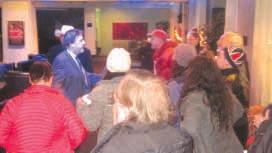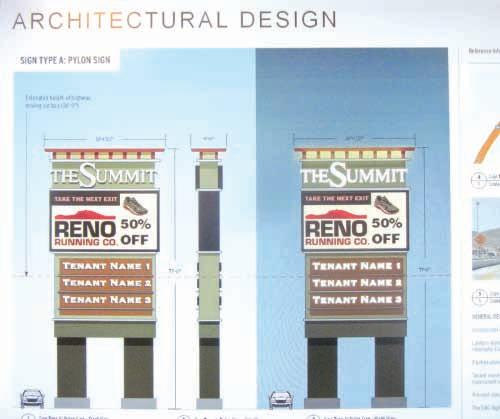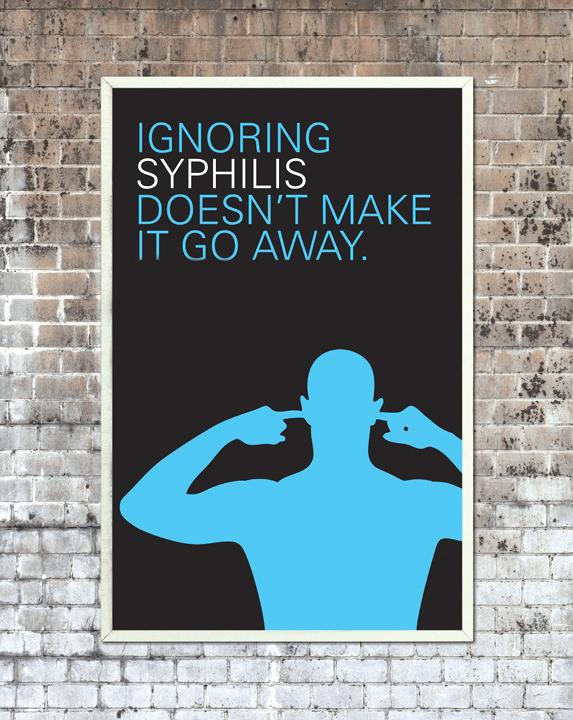
8 minute read
News
from Dec. 18, 2014
A message instead of money

Advertisement
It was a little like the restaurant scene in Doctor Zhivago.
At Reno’s Siena Hotel Casino, a group of affluent lobbyists and Republicans were on hand to give money to Nevada Assemblymember James Wheeler. A group of community activists who had quietly arrived began chanting “I can’t breathe”— the last words spoken by Eric Garner, the unarmed man who died after being put in an apparent choke hold by a New York City police officer in July. The chant was repeated 11 times, the same number that Garner spoke the sentence. Wheeler (facing the protesters in photo) kept saying, “Neither can I.”
The protest was less over Wheeler’s well-known comments about voting to reinstate slavery than his actual voting record. “He is also the only legislator who scored worse on racial equity (48 percent) than Ira Hansen (42 percent) in the last session,” read a planning document for the protest.
After making their point, the protestors filed out. Following their departure, Wheeler told his contributors, “No extra charge for the entertainment.”
Database called public service
A U.S. House member has attested to the value of the Fatal Encounters database developed by RN&R editor Brian Burghart and urged federal support for academic partners who are joining the effort.
“Mr. Burghart’s work is critical to complementing our legislative efforts,” wrote U.S. Rep. Alan Grayson of Florida. “Already, activist groups such as Color of Change are using his data to educate public policymakers. I believe the Department of Justice will not compile such a database unless it is forced to do so by a competing credible academic database.”
Burghart launched the website in February, and the August shooting of Michael Brown in Missouri brought it to considerable prominence. Particularly because it lists more incidents than federal databases such as that of the Federal Bureau of Investigation.
Congress last week re-enacted the Death in Custody Reporting Act, a federal law that lapsed eight years ago, but Burghart’s efforts continue. While the original act was in effect, 2000-2006, it was largely ignored by official agencies.
Low oil prices reduce fracking?
A Bureau of Land Management auction of oil and gas leases in Reno last week came to little when only one of 97 parcels offered was bid on. BLM and petroleum execs spun the story as a case of sage grouse protections scaring off oil companies, but environmental spokespeople said the facts don’t fit that scenario.
“Fascinating, since sage grouse parcels were all removed from the sale before it began,” said wildlife biologist Erik Molvar of Wild Earth Guardians in an email message to an associate. “The real answer is probably that low crude oil prices make horizontal fracking operations unprofitable.”
Fracking is forcing a water/chemical/sand mixture into the earth tap shale for fossil fuels. It is relatively unregulated. Nevada does not require disclosure of the ingredients being forced into the ground, nor does any other state, and the federal government exempts fracking from clean air and water laws. —Dennis Myers
An exhibit showed one of the two signs planned for Summit Sierra. This one includes a digital screen and was rejected by the Reno Planning Commission. A second sign did not include the screen and was approved.
High light
Battle joined over Summit Sierra signs
The Reno City Planning Commission last week approved a seven-story sign for by Summit Sierra mall and rejected a Dennis Myers second such sign. Scenic Nevada, which as Citizens for a Scenic Reno won a 2000 voter-approved enactment of a ban on new billboards in Reno, said the Summit signs are billboards and should be disallowed. “This sign is not a billboard. … It is not governed by the city’s digital billboard ordinance,” said Summit lawyer John Frankovich.
John Frankovich summit sierra
The two signs are a little more than 70 feet high and stand on concrete pedestals. They are akin to signs adjacent to the freeways that pass the Sparks Nugget and the Grand Sierra Resort in Reno. One of them has a digital screen, and that one was rejected by the commission.
Frankovich said up to five billboards are allowed in the area, which Summit has agreed to forgo if its two monolithic signs are allowed, a proposition that Scenic Nevada spokespeople called a threat.
“If we don’t give them what they want, they’re going to make it worse,” said Scenic Nevada lawyer Mark Wray.
Scenic Nevada members were already doing a slow burn when they arrived at the meeting. They believed they had the battle won at a Dec. 4 meeting, whereupon Summit was given a continuance.
“When there’s a tie vote, the applicant gets [an extension] and there’s a later date,” said Scenic Nevada board member Peter Neumann. He also told the planning commission members that “the staff [was] meeting behind your back” to work out a deal with Summit.
There were times during the meeting when staffers seemed to come to the aid of Summit, although whether it was advocacy or just keeping the commissioners informed is a subjective call. Frequently, it came when there were differences over definitions. For instance, at one point the issue was raised whether the change on the digital face of the sign from one image to another constituted a “flashing” sign, and a staffer said that it has not normally been defined that way. She said that “flipping from one scene to another every ten seconds” does not flash, and to demonstrate it, she had a Summit representative switch images on a computer that was putting material on wall screens.
Commissioner Douglas Coffman argued that because the technology is advanced, that made it “progressive technology. I think it’s where signage is going. … It’s not as offensive to me.”
Frankovich similarly argued that “the digital is new technology … safer and more effective.” But he also made the case that there’s nothing wrong with relatively obtrusive signs in that particular region, because that’s the way it is expected to go. In fact, he pointed out, there is a casino hotel approved for the area, which is true, though it is a fairly stale approval that has never moved much beyond the approval stage.
Wray responded, characterizing Frankovich’s pitch as “There’s going to be all kinds of crappy signs, so what difference does it make if we have them, too?”
Summit was seeking approval to bend the city’s rules on signs dealing with height, the size of the sign’s face, the number of lights in the sign, and the “variables”—that is, the number or frequency of times the image on the sign changes.
The opponents took repeated shots at the height of the sign, often calling it “seven stories tall” and arguing it could be “seen for miles.” That was a sore spot because there were comments from the commissioners about signs at the Grand Sierra Resort that can be seen for long distances. Commissioner Paul Olivas called the GSR sign the “most obnoxious” in the valley. No one seemed to want to approve another sign that incurred the same level of public displeasure.
“These are very bright signs,” Neumann said in his testimony. “They have more than a million lights—LED lights—in them.”
“There are “no moving parts, no flashing,” Frankovich said. “The change [of images] is not a flash.” In addition, they are adjacent to the freeway, intended to be seen by freeway drivers—“You’ve got to go 40 feet before you reach the level of the freeway.”
Olivas also said the commissioners must follow existing standards for signage.
“We’re not here to write the rules, but we’re here to apply them,” he said—though he also referred to “holes and inconsistencies” in the rules.
Wray told the commissioners, “If this was OK ... then he [Frankovich] wouldn’t be coming
before you for permission to bend the rules. … They’re making a mockery of the standards you’re supposed to be following.”
Frankovich interpreted the silence of people who live in the area as consent to the signs.
“There is nobody from the surrounding neighborhoods that has come to complain,” he said.
The proposed signs are on-premise, meaning they advertise merchants on the same property where the sign is located. South Reno resident Barbara Rainey was not impressed by that line of argument.
“A hundred percent of the impact of this sign is off premise,” she said.
A study done at the request of Scenic Nevada by state highway officials was invoked against the Summit signs, prompting Frankovich to trivialize the study. That made Commissioner Peter Gower say there is “useful information in it, and I thought it was fairly compelling.”
The meeting was held Dec. 11. Scenic Nevada board member Lori Wray informed the meeting that just the evening before, the Reno City Council had agreed to a moratorium on on-premise digital billboards. “Approving this may be premature,” she said.
The moratorium is on noncasino and non-mall applications.
After the commissioners voted down the digital sign and approved the non-digital version, there were some defenses of the city staffers as having acted “in good faith.”
The buck does not stop with the commission. The Reno City Council has final say on whether to approve the signs, so Scenic Nevada will have to continue gthe effort. The group sent a Dec. 16 notice to its members, telling them, “The planning commission’s decision is final unless appealed by December 22 to the Reno City Council.” That prompted another community activist write to her mailing list: “As one businessman remarked to members of the city council last week, it is like the wild west here. We need to clean this up. We need to speak out against allowing this visual pollution to destroy our communities and region.”
Mark Wray said later that Scenic Nevada is not in the habit of fighting every eyesore that comes along. “We don’t fight a lot of things,” he said. Ω

Mark Wray Scenic nevada
AND HIV
Troubled bridge over waters

During preparations for the Great Santa Dash on Saturday morning, a Reno motorcycle officer took a ride over the pedestrian bridge to check out some action in Wingfield Park.
Get Tested, Get Treatment, Get Talking
Call (775) 328-6147 for free and confidental testing
This message brought to you by the Washoe County Health District with grant funding from the CDC through the Nevada Division of Public and Behavioral Health.










